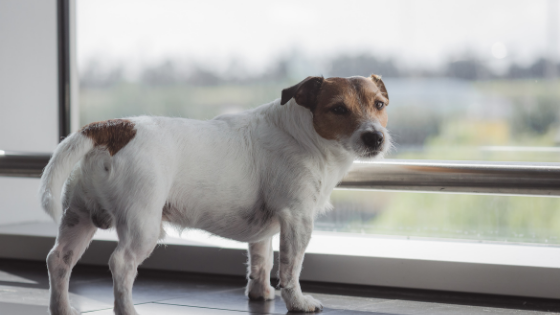
22 OctDoes Your Dog Have Anxiety?
Anxiety in dogs is much like anxiety in humans – it can be related directly to certain stimuli such as thunderstorms, strangers, or separation from their owner, or it can present as generalized anxiety. Anxiety can be triggered into greater severity by specific stimuli, but dogs with more generalized anxiety are likely to show anxious behaviors on a more consistent basis and the triggers may be more variable or difficult to pinpoint. Additionally, dogs with non-generalized anxiety are often triggered before the presence of certain stimuli in anticipation of stressful events.
What does anxiety look like?
Anxiety in dogs is nearly always rooted in some form of fear. This is important to remember when working with anxious dogs, as punishment for undesirable behavior associated with their anxiety can make it worse.
Common behaviors displayed by anxious dogs can include shaking, panting, pacing, excessive drooling, barking, whining, hiding, urinating and defecating. You can also look for more subtle cues from a dog’s body language such as keeping their ears pinned back or maintaining a closed mouth with tight lips, or noticing if the dog freezes.
Every dog is different and may display anxiety in different ways, so getting to know your dog and how they respond when anxious is always the best way to start.
Many of these behaviors can appear in other circumstances (urinating and defecating can be related to house training, etc.), but being attentive to your pet, their triggers, and the rest of their body language and behavior will give you clues about whether what you are noticing is related to anxiety or not.
What can I do?:
When working with an anxious dog, it is especially important to ensure a stable environment with consistency in training and routine. This consistency will help your dog to predict what is happening next and help to reduce their anxiety and stress levels.
While we always recommend positive reinforcement training, this is imperative for an anxious dog, as aversive stimuli can increase anxiety and be highly counterproductive in their training. There are a lot of ways to work with anxiety but some easy places to start are increasing exercise to help your dog simply tire themselves out! If your dog loves toys or chasing a ball or simply going for nice walks, all of these can ease anxiety in the moment, but also help longer term with their energy levels.
Similarly, increasing mental enrichment by using long lasting chews like rawhide or pigs ears, or Kongs with peanut butter inside can really help out if you dog is suffering from anxiety in the home. These give your dog something to do and something to focus on in a constructive manner and can provide a surprising amount of help in cases of low-to medium-level anxiety.
If you notice your dog responds well to any particular situation or stimuli, try your best to use these situations or stimuli to your advantage and provide them to your dog whenever you begin to notice anxious behaviors. In some cases, anxiety may be more severe and may be causing lack of appetite, lack of interest in toys, or an inability to go for walks. For these dogs their anxiety is causing a severe impact on their quality of life and well-being and it is advisable to take them to a vet to rule out any physical problems that may be contributing to anxiety, fearfulness, or energy level.



